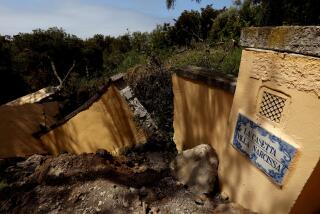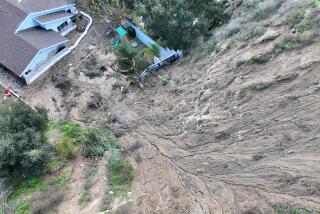Canyon Residents Prepare for Worst : Emergency: Pasadena Glen homeowners use sandbags to protect property. They are accustomed to the ferocity of nature.
It was almost 12 years ago to the day that Terry McGough of Pasadena Glen first saw the walls of water from the San Gabriel Mountains that have made his neighborhood one of the most notorious in local flood control lore.
In the space of a few days, torrential rains flooded into the narrow canyon, washing away three cars, burying a trailer in mud and leaving a trail of car-sized granite boulders from high up the mountain scattered over the roadway. A friend’s four-wheeler was trapped in their normally trickling creek and pulverized into a hunk of scrap metal.
This week’s storm has revived McGough’s memories of 1980--and then some. Not long after the first drops of rain began to fall on Southern California, he watched in amazement as a wall of water came down from the mountains and took away a Cadillac.
“It just picked it up, floated it a little and then dumped it in the river,” McGough said Wednesday as he prepared for another round of sandbagging around the neighborhood. “It was just like somebody just drove it right over the edge.”
In Pasadena Glen--a spot enshrined by John McPhee in his book, “Control of Nature,” an exploration of mankind’s sometimes vain attempts to control natural phenomena--residents are in high gear for yet another great battle against the flood.
The latest wave of rain and rising floodwaters has left foothill dwellers all over Southern California waiting, watching and preparing for the worst. But for residents of the Glen, such scenes have taken on the familiarity of ritual.
The residents of the rustic hamlet in the foothills above northeastern Pasadena have sandbagged critical areas to prevent floodwaters from spilling onto their street and, in some cases, left for safer ground.
Despite their efforts, several waves of water that descended Monday night left boulders, tree trunks and tons of mountain sand strewn across the neighborhood.
“You don’t get a lot of sleep when it rains like this,” McGough said as a raging river of mud, sand and rock flowed down the middle of his street.
County workers and firefighters made periodic stops Wednesday to check on the neighborhood--a spot well-known to flood control experts as one of the most precarious places that anyone calls home in the foothills.
The local fire station usually rations homeowners to a few dozen sandbags each. In Pasadena Glen, they give them all they can handle. “They know who we are,” McGough said.
Pasadena Glen begins as a narrow canyon, barely wider than an arm’s length. Unlike other areas where streams rise gradually before topping their banks, the mountain runoff in Pasadena Glen descends in unexpected, violent bursts. A big wave can tear down the concrete-lined creek in the center of the canyon, creating a rumbling din as boulders and debris clack against each other.
At other times, runoff flows harmlessly down a 15-foot-deep concrete channel. But after even just a few hours of rain, the channel can fill with sand and debris, bringing the floodwaters close to street -level.
On a lower section of the road, where residents have already sandbagged the street, the channel is filled with debris to within a couple feet of the pavement.
Farther up the road, the waters already have broken part of the concrete banks and are threatening to wash away the road.
For all the potential danger, residents in the Glen were taking the storm in stride.
Linda Baker was temporarily marooned at McGough’s house after floodwaters crossed the road, cutting her off from her house on the upper section of the street.
“I had this lovely trickling stream when I moved in here,” she said Wednesday. “This is the first time I’ve seen water pour down like this. It’s a kick.”
Baker downplayed the hazard. “This is a once-in-a-decade kind of thing,” she said. “It’s a great place to live. At least no one drives by my house and shoots at me.”
By Wednesday afternoon, McGough had decided it was time to organize some neighbors to being sandbagging the upper section of the street.
Their plan was to lay a wall of sandbags about four feet high across the street to guide the expected walls of water back into the channel. He figured that should hold all but the wildest waves.
“But you know, this water can move a car, it can move a boulder down the street,” he said. “It’ll move sandbags, no problem.”
Stormy Weather
With the likelihood of more storms hitting Southern California, emergency officials are recommending that residents in flood-vulnerable areas take several basic precautions. Here are some of the suggestions:
Preparing for a Flood
* Keep your automobile fully fueled.
* Keep a stock of fresh water (in clean bathtubs and large containers) and first aid supplies available in case water service is cut off.
* Keep a supply of food that does not require refrigeration in case of electrical outages.
* Keep a portable radio and working flashlights (with batteries) on hand.
* Plan a safe evacuation route.
During the Storm
* Sandbag exposed sections of your home, such as the driveway and home entrances. Sandbags can usually be obtained for little or no cost at local fire departments.
* Seal all openings into your home, such as sliding glass doors, using plastic garbage bags, towels or weather stripping.
* Cover all air vents under your home with plywood, brick or sandbags to prevent water leakage.
* If there is any threat or mudslide, cover sliding glass doors and windows with plywood.
* If forced to leave your home, turn off natural gas supply at the meter, shut off electricity to the home and unplug electrical appliances.
* Do not attempt to ford or drive across a flooded stream.
After the Flood
* On returning home, be sure to use only a flashlight during inspection because of the possible presence of explosive fumes.
* Make sure all electrical equipment is dried and checked before returning to service.
* Do not eat any food that has come in contact with flood waters.
SOURCE: Los Angeles County Dept. of Public Works, American Red Cross and Los Angeles City Fire Department, Southern California Gas Company
More to Read
Sign up for Essential California
The most important California stories and recommendations in your inbox every morning.
You may occasionally receive promotional content from the Los Angeles Times.











